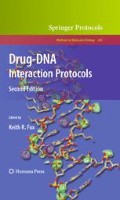Abstract
The targeting of telomerase and telomere maintenance in human cancer cells can be achieved by small molecules that induce the 3'single-stranded ends of telomeric DNA to fold up into four-stranded quadruplex structures that inhibit the action of the telomerase enzyme complex. In this chapter, we describe a series of biochemical, biophysical, and cellular assays that are used to evaluate the activity of new compounds, and so assess whether they are suitable for examination in xenograft models of human cancer. These assays evaluate quadruplex stabilisation properties, short- and long-term cell viability, telomerase enzymatic activity, cellular senescence, and telomere length changes.
Access this chapter
Tax calculation will be finalised at checkout
Purchases are for personal use only
References
de Lange T (2005) Shelterin: the protein complex that shapes and safeguards human telomeres. Genes Dev 19:2100-2110
Autexier C, Lue NF (2006) The structure and function of telomerase reverse transcriptase. Annu Rev Biochem 75:493-517
Kim NW, Piatyszek MA, Prowse KR, Harley CB, West MD, Ho PLC, Coviello GM, Wright WE, Weinrich R, Shay JW (1994) Specific association of human telomerase activity with immortal cells and cancer. Science 266:2011-2015
Hahn WC, Stewart SA, Brooks MW, York SG, Eaton E, Kurachi A, Beijersbergen RL, Knoll JH, Meyerson M, Weinberg RA (1999) Inhibition of telomerase limits the growth of human cancer cells. Nat Med 5:1164-1170
Oganesian L, Bryan TM (2007) Physiological relevance of telomeric G-quadruplex formation: a potential drug target. Bioessays 29:155-165
De Cian A, Lacroix L, Douarre C, Temime-Smaali N, Trentesaux C, Riou J-F, Mergny J-L (2008) Targeting telomeres and telomerase. Biochimie 90:131-155
Sun D, Thompson B, Cathers BE, Salazar M, Kerwin SM, Trent JO, Jenkins TC, Neidle S, Hurley LH (1997) Inhibition of human telomerase by a G-quadruplex-interactive compound. J Med Chem 40:2113-2116
Monchaud D, Teulade-Fichou MP (2008) A hitchhiker’s guide to G-quadruplex ligands. Org Biomol Chem 6:627-636
Tan JH, Gu LQ, Wu JY (2008) Design of selective G-quadruplex ligands as potential anticancer agents. Mini Rev Med Chem 8:1163-1178
Mergny J-L, Lacroix L, Teulade-Fichou MP, Hounsou C, Guittat L, Hoarau M, Arimondo PB, Vigneron J-P, Lehn J-M, Riou J-F, Garestier T, Hélène C (2001) Telomerase inhibitors based on quadruplex ligands selected by a fluorescence assay. Proc Natl Acad Sci U S A 98:3062-3067
Gomez D, Wenner T, Brassart B, Douarre C, O’Donohue M-F, El Khoury V, Shin-ya K, Morjani H, Trentesaux C, Riou J-F (2006) Telomestatin-induced telomere uncapping is modulated by POT1 through G-overhang extension in HT1080 human tumor cells. J Biol Chem 281:38721-38729
Gomez D, O’Donohue M-F, Wenner T, Douarre C, Macadré J, Koebel P, Giraud-Panis M-J, Kaplan H, Kolkes A, Shin-ya K, Riou J-F (2006) The G-quadruplex ligand telomestatin inhibits POT1 binding to telomeric sequences in vitro and induces GFP-POT1 dissociation from telomeres in human cells. Cancer Res 66:6908-6912
Leonetti C, Amodei S, D’Angelo C, Rizzo A, Benassi B, Antonelli A, Elli R, Stevens MFG, D’Incalci M, Zupi G, Biroccio A (2004) Biological activity of the G-quadruplex ligand RHPS4 (3, 11-difluoro-6, 8, 13-trimethyl-8H-quino[4, 3, 2-kl]acridinium methosulfate) is associated with telomere capping alteration. Mol Pharm 66:1138-1146
Gunaratnam M, Greciano O, Martins C, Reszka AP, Schultes CM, Morjani H, Riou J-F, Neidle S (2007) Mechanism of acridine-based telomerase inhibition and telomere shortening. Biochem Pharmacol 74:679-689
Schultes CM, Guyen B, Cuesta J, Neidle S (2004) Synthesis, biophysical and biological evaluation of 3, 6-bis-amidoacridines with extended 9-anilino substituents as potent G-quadruplex-binding telomerase inhibitors. Bioorg Med Chem Lett 14:4347-4351
Reed JE, Gunaratnam M, Beltran M, Reszka AP, Vilar R, Neidle S (2008) TRAP-LIG, a modified TRAP assay to quantitate telomerase inhibition by small molecules. Anal Biochem 380:99-105
Moore MJ, Schultes CM, Cuesta J, Cuenca F, Gunaratnam M, Tanious FA, Wilson WD, Neidle S (2006) Trisubstituted acridines as G-quadruplex telomere targeting agents. Effects of extensions of the 3, 6- and 9-side chains on quadruplex binding, telomerase activity, and cell proliferation. J Med Chem 49:582-599
De Cian A, Guittat L, Shin-Ya K, Riou J-F, Mergny J-L (2005) Affinity and selectivity of G4 ligands measured by FRET. Nucleic Acids Symp Ser (Oxf) 235-236
Brassart B, Gomez D, De Cian A, Paterski R, Montagnac A, Qui KH, Temime-Smaali N, Trentesaux C, Mergny J-L, Gueritte F, Riou J-F (2007) A new steroid derivative stabilizes G-quadruplexes and induces telomere uncapping in human tumor cells. Mol Pharmacol 72:631-640
Burger AM, Dai F, Schultes CM, Reszka AP, Moore MJ, Double JA, Neidle S (2005) The G-quadruplex-interactive molecule BRACO-19 inhibits tumor growth, consistent with telomere targeting and interference with telomerase function. Cancer Res 65:1489-1496
Leonetti C, Scarsella M, Riggio G, Rizzo A, Salvati E, D’Incalci M, Staszewsky L, Frapolli R, Stevens MF, Stoppacciaro A, Mottolese M, Antoniani B, Gilson E, Zupi G, Biroccio A (2008) G-quadruplex ligand RHPS4 potentiates the antitumor activity of camptothecins in preclinical models of solid tumors. Clin Cancer Res 14:7284-7291
Author information
Authors and Affiliations
Corresponding author
Editor information
Editors and Affiliations
Rights and permissions
Copyright information
© 2010 Humana Press, a part of Springer Science+Business Media, LLC
About this protocol
Cite this protocol
Gunaratnam, M., Neidle, S. (2010). An Evaluation Cascade for G-Quadruplex Telomere Targeting Agents in Human Cancer Cells. In: Fox, K. (eds) Drug-DNA Interaction Protocols. Methods in Molecular Biology, vol 613. Humana Press. https://doi.org/10.1007/978-1-60327-418-0_19
Download citation
DOI: https://doi.org/10.1007/978-1-60327-418-0_19
Published:
Publisher Name: Humana Press
Print ISBN: 978-1-60327-417-3
Online ISBN: 978-1-60327-418-0
eBook Packages: Springer Protocols

